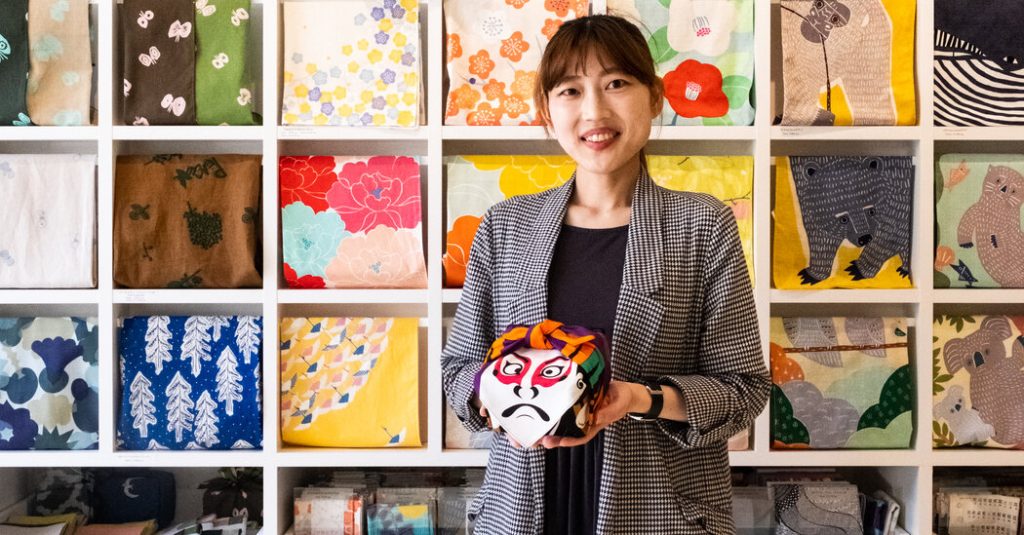Gift Wrapping That Doesn’t Create Waste
5 min read
A gift without wrapping is like a cake without frosting — and where’s the fun in that? Yet the waste associated with hard-to-recycle wrapping paper means that, for many people, only reusable materials will do.
You don’t need to tell that to the Japanese. Centuries ago, they elevated the practice of wrapping gifts using fabric, known as furoshiki, into an art form.
For a lesson on furoshiki history, design and wrapping techniques, The Times went to a prime source: Yamada Sen-i, a manufacturer and wholesaler of furoshiki, founded in Kyoto in 1937. The company, which owns the furoshiki brand Musubi with retail stores in Tokyo and Kyoto, offers more than 500 patterns, including traditional motifs such as cranes and flower blossoms as well as contemporary designs, ranging from 350 yen to 35,000 yen ($2.35 to $235).
On a video call last month from the company’s headquarters in Kyoto, Kensuke Kawamura, Yamada Sen-i’s head designer, and Ayano Hasui, head of international sales and press, shared their tips for wrapping, reusing and gifting furoshiki.
With more than 25 wrapping techniques included in “The Furoshiki Handbook,” available on Musubi’s website, the design options are virtually endless. But they all come down to the same thing, Ms. Hasui said: “To show your care to the receiver.” The discussion has been edited for length and clarity.
What is the history of furoshiki?
AYANO HASUI Furoshiki have been used for more than 1,300 years. There is a record from the Nara period, from 710 to 794, and it shows people keeping valuables wrapped in a fabric called tsutsumi that was a predecessor of today’s furoshiki.
As time went by, people started to use it in daily life.
In the 15th century, for example, people brought their clothing to the public baths with furoshiki.
The name furoshiki comes from “furo,” which means public bath in Japanese, and “shiki,” which is a kind of sheet or mat.
Now using furoshiki as a bag is most popular, both for yourself — plastic bags are not free anymore in Japan, so we use them when we go to the grocery store — and also for gifts.
How big is a typical furoshiki and what is it made of?
HASUI We mainly sell three sizes, the smallest one is 50 centimeters [almost 20 inches], the medium is 70 centimeters, and the large size is, commonly, 100 centimeters. It’s a square, but it’s not a perfect square, actually. That’s one of the traits of a furoshiki. There is a slight difference between the width and the length. That’s because it makes it easier to wrap.
KENSUKE KAWAMURA Traditionally, we use silk. However, these days we have developed furoshiki made out of more sustainable materials such as organic cotton or recycled polyester.
What about the patterns, decorations and colors commonly found on furoshiki?
KAWAMURA [Holding up a navy blue furoshiki with a stylized floral pattern on half of the piece] This is quite a traditional pattern. The main pattern is always on the bottom half of the furoshiki, because when we wrap it the main pattern sits in the center.
Traditional patterns include auspicious motifs such as cranes, turtles and pines.
[Holding up a furoshiki printed with peonies in bright colors] This contemporary furoshiki is actually the best-selling design of the company; we collaborated with the French designer Adeline Klam (the first time we worked with a designer from overseas).
This motif is quite traditional, but coloring and layout is very contemporary.
What is a basic technique for wrapping with furoshiki?
HASUI [Using a pink and light green furoshiki with a plum flower pattern] We recommend working with reversible furoshiki because this makes for a beautiful color contrast.
In a basic technique, you place the furoshiki at an angle, so it’s a diamond shape, and place the gift box in the middle. The you pull the corner at bottom over the top of the package and tuck it under.
Then you bring the top corner of the furoshiki down over the box and fold the bottom corner back up into a triangle, so the reversible side is visible.
Then you pinch the right side of the furoshiki and pull it tight over the edge of the package and do the same thing on the other side. Make sure the corners are sharp.
We’ll tie the ends with the most classic tie, called ma-musubi in Japanese, kind of a square knot.
And then you just tie them in a simple bow.
And then you pull out the fabric of the bow so you can see the reversible pattern.
Any tips or advice on wrapping techniques?
HASUI The size of furoshiki is really important. The gift should be one third of a furoshiki for the best fit — meaning the gift should take one third of the horizontal space if you’re looking at a furoshiki laid out in a diamond shape.
KAWAMURA If you want to show your consideration, choose seasonal patterns or patterns that a person would like. For example, if I want to give something to my father, maybe I choose a pine pattern because it has a meaning of long life.
On what occasions do you present gifts with furoshiki?
KAWAMURA When I go to a friend’s house, I always bring wine like this. [Displaying a furoshiki with two bottles double-wrapped inside.]
HASUI Making the double-wrapped bag is not that difficult. Place the furoshiki in a diamond shape, like before. Put the two bottles horizontally in the middle, with the bottoms facing inward, but make sure you have two or three centimeters of space between the bottoms.
Pull up the bottom corner of the furoshiki and cover the bottles. Roll the bottles away from yourself until you have used the whole piece. Pick up the corner of the fabric at bottom and tuck it in between the bottles. This will be the cushion between them. Then you raise the bottles and stand them up. And we make ma-musubi, the classic knot, on top.
How can you reuse a furoshiki?
KAWAMURA My wife and I use them for gifts, and we always wrap cushions with furoshiki. We can change it very easily along with the season. We never buy pillowcases.
HASUI After you unwrap the wine, you can use it as a bag. And apart from that, there are some ways of using it as an organizer for your travels. And it can be framed — you can use it as wall décor. The trait of furoshiki is versatility.





